the destroyer > cheap papers > Sarah Todd
SHOTS RING OUT
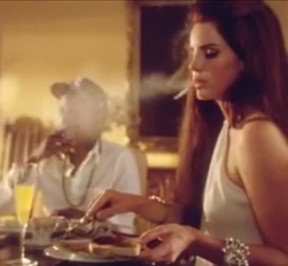
Lana del Rey is a pusher, and she traffics in Americana. Her music video for “National Anthem” is no exception. The camera gorges on a Kennedy-era feast of bouffants and crisp A-lines, mansions on the Cape, a little low-down dancing. As Jackie O., del Rey looks effortlessly glamorous smoking a cigarette while she butters her toast. The shores are appropriately rocky, the sweaters loosely knotted. There’s just enough whiskey in everybody’s tumbler so you can tell they’re sailing. All this is filmed in bleached-out light, frayed edges bordering every frame. “This video looks like it was produced in Instagram,” YouTube commenter Charles Wolford writes, cuing the cinephile groans. Can’t anyone recognize 8 millimeter when they see it?
But Wolford has it right. The aesthetics of nostalgia are more Instagram than Super 8, more click-and-save than roll it. Nostalgia lays present-day fantasies over the past like an automatic filter. It’s also a luxury available mostly to the privileged: the people who get moony-eyed about the past while ignoring its injustices tend to be the ones who have it pretty easy in the present.
Two music videos released this summer expose the complacency of our contemporary nostalgia for the early 1960s, refusing to let racism and violence fade into the background. The first, del Rey's "National Anthem," disrupts its Camelot reverie with a casting choice that changes what kind of story it’s telling. The second, Santigold's "Keepers," distorts the model American nuclear family into a nightmare straight out of David Lynch.
On the surface, “National Anthem” hits all the traditional notes of the Kennedy myth. But the video never lets the viewer settle into the fantasy, largely thanks to one key change: the African-American rapper A$AP Rocky plays the JFK to del Rey’s Jackie O.
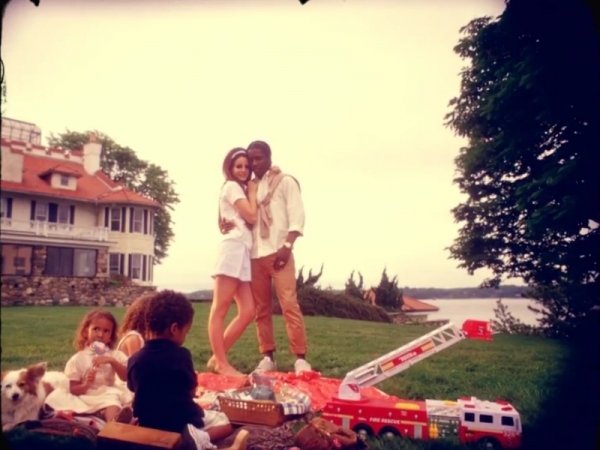
This casting both enhances and disrupts the music video’s fantasy of the past. By revising history to include a black president fifty years early and an interracial First Couple, the video improves upon America's shameful history of segregation and discrimination. But the effect is not to gloss over that history—as nostalgia often does—but to make it more visible.
The intimacy between the two stars, who have each expressed interest in each other off-screen, is mesmerizing. Del Rey breaks into peals of delighted laughter as he makes a boisterous speech over the dinner table; he blows her a kiss that she catches while standing on a balcony in a wide-brimmed hat. They pose with their adorable children on a sprawling lawn. But as the camera returns again and again to tender shots of del Rey’s hand on Rocky’s knee, her fingers grazing his chest along the fold of his open shirt, the video reminds us that this version of history is a fantasy. What we’re watching isn’t the Kennedys. We’re watching something better, something that we couldn’t have seen in 1963. “It's a love story for the new age,” del Rey purrs.
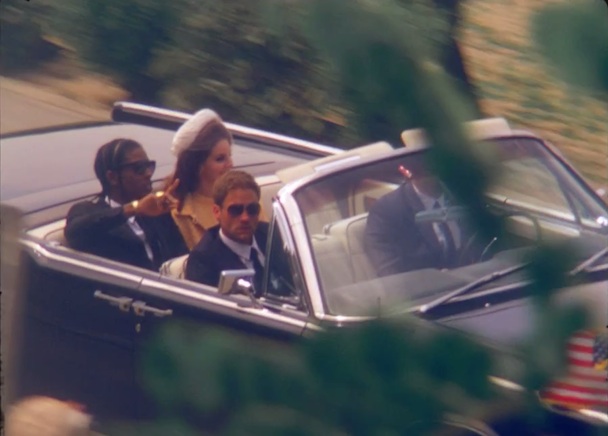
Casting Rocky as JFK also racializes the president’s assassination. The threat of violence looms over the lush fantasy from the get-go. The moment after Rocky’s face appears through a cloud of cigar smoke, the camera cuts to his hand on del Rey’s thigh. Then come screams, the edges of a motorcade, a pair of legs running. Since all this happens before their love story plays out, a sense of foreboding—and memories of the rampant racism in America’s very recent history—hangs over Camelot.
The lyrics of the song, too, pose a sneaky challenge to “National Anthem”’s nostalgic imagery. “Money is the anthem of success," del Rey sings, channeling a pouty Marilyn Monroe. The song is about aspiration, the climb from being the girl who sings “He says to be cool but / I don’t know how yet” to becoming the one who knows, “He says to be cool but / I’m already coolest.” Yet the song’s fantasy has a dark side. The dream life of “Wining and dining, drinking and driving” becomes “overdosing and dyin’ / on our drugs and our love / and our dreams and our rage.” Del Rey knows that she’s selling an illusion of the past, equal parts melodramatic and honey-hued. But she includes enough discord so that the fantasy never congeals. “We will do very well, I can tell, I can tell," del Rey sings, "Keep my safe in his bell tower hotel.” But nothing stays safe for long.
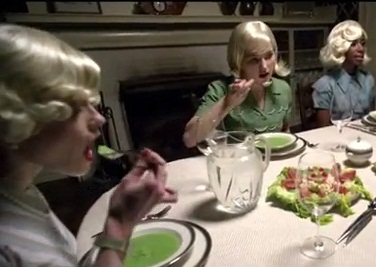
Santigold’s “The Keepers,” which also debuted this summer, confronts even more directly the venom lurking just beneath the surface of our nostalgia for the 1960s. The song's chorus is an indictment of modern-day obliviousness to the plights of others: "We're the keepers / While we sleep in America / Our house is burning down.”
In the video’s opening moments, a blonde family with toothpaste-commercial smiles gathers for a Leave It to Beaver-style family dinner. But this nostalgia is grotesque from the get-go. They lift their soup spoons in synchronized movements. When they're done, they bang their forks and knives on the table in menacing, Stepford-like unison: they look like they’re out for blood. There's nothing wholesome about this family, only an insularity that allows them to ignore the fact that every plate on their table is glowing a toxic shade of green. All that matters is that they maintain appearances. When the matriarch rises from the dinner table mid-meal, she models her curves like she's her own car show. She pats her hair proudly, her lips painted into a Joan Crawford bow.
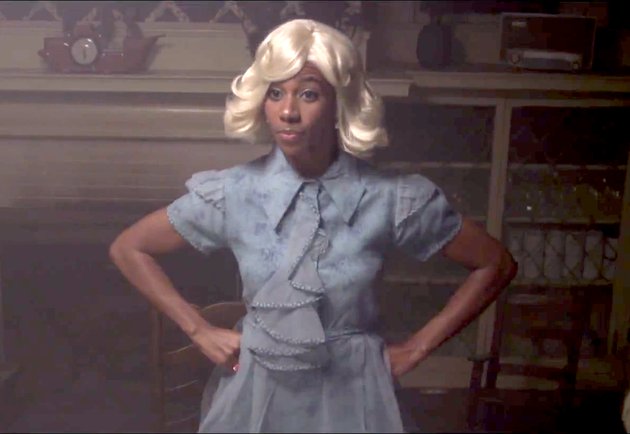
Like “National Anthem,” “The Keepers” calls attention to the racial mores of the period by casting its star in an anachronistic situation. In this case, Santigold plays a child in what appears to be an ultra-conservative and otherwise white suburban family, wearing a loose blue dress and a stiff blonde wig that matches that of her sister. The other African-American characters in the video, however, are clearly on the margins of the American dream. An African-American domestic worker wordlessly clears their plates and serves the family radioactive fish. And midway through the video, a car filled with white and black men, including Wu-Tang’s GZA, fire at the house in a drive-by shooting. Based on the shooters’ clothing and speech, they seem to be from the present, which makes sense—in the realm of “The Keepers,” the suburban family that exists in reality that bears no relation to the world beyond their four walls.
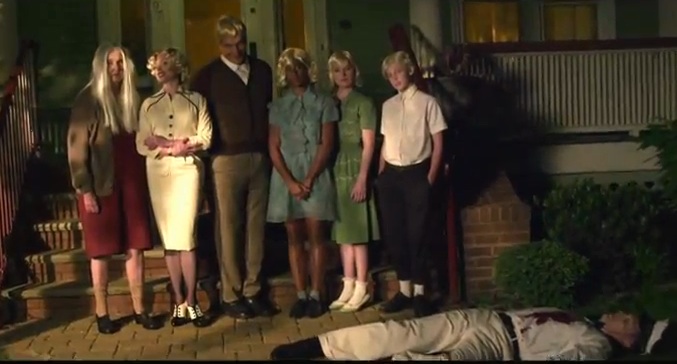
So firmly is the family committed to preserving the retro-fantasy of safety that they’re back at the table as soon as the bullets stop flying. The father holds out his palms, reassuring them with a good-old-boy grin. But their fortifications from the outside world are crumbling. When the milkman comes to the door, he has a small bullet hole in his chest. He and Santigold gladly shake hands, but soon he’s falling to the floor, the rest of the family rushing around him a panic. Santigold stays upbeat, marching around the living room with her chest puffed out, hands on hips, a child mimicking military precision. “What happens when you get stuck?” Santigold sings. “Get to the bottom of the illusion that you’re in.” But the family’s capacity for illusion is bottomless. By the final frame of the video they’re gathered outside a burning house, the mailman’s corpse laid out in front of them. But they still look as if they’re posing for a Christmas card.
What Santigold’s video reveals, much more than del Rey’s, is the conservative nature of nostalgia. Romanticizing the past doesn’t just obscure any progress that’s been made. It also blocks, and poisons, dreams for the future. America’s strengths don’t lie in the tailored clothes and leafy suburbs and severely restricted opportunities of our past. Its strengths lie in how much our country has changed—and in how, with any luck, we may continue to.
[author's website]








